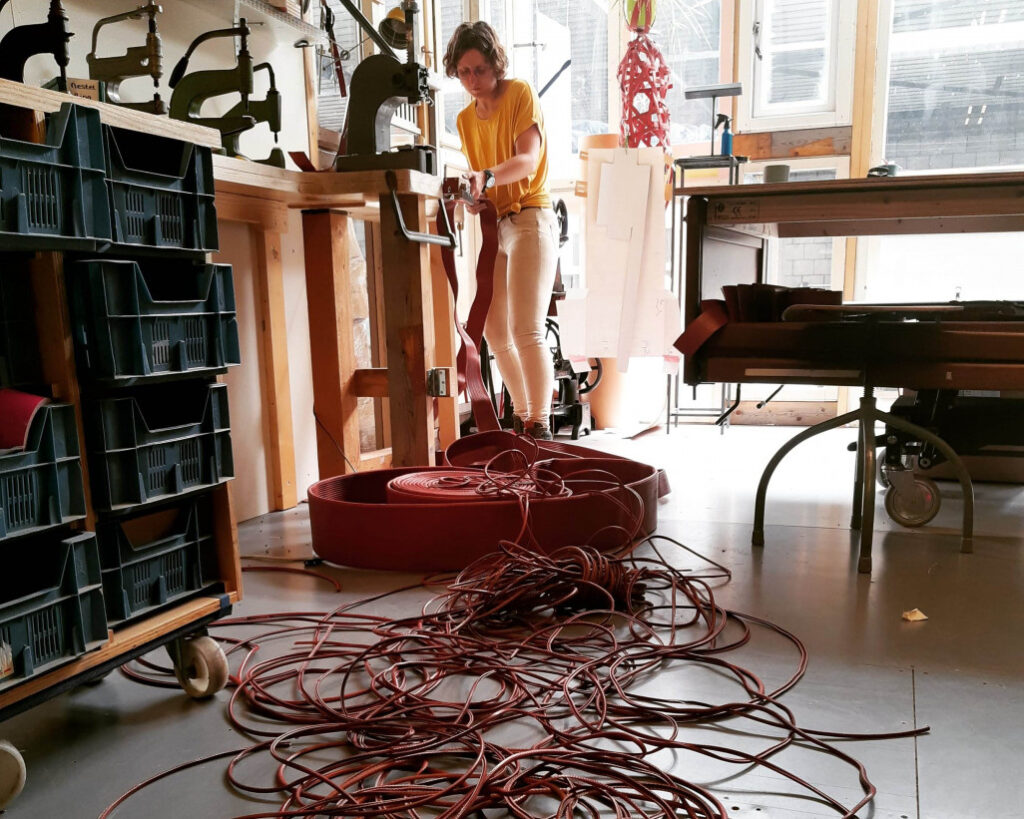The Dutch Design Week started this weekend. Visitors to Eindhoven can delve into future design for ten days, spread over 120 places in the city. You should not miss these special designs.
Fifty shades of red
Designer Ilse Evers relaxes into a bright red chair. It is made from old fire hoses, just like the rest of her collection.
“I make belts, bags, but also lamps and stools. All from fire hoses. My neighbour once gave me such a hose. Then I looked at the material from all sides and started to take it apart. I discovered that it is very strong material. It is colourfast, with a very nice shine. And you can use it both indoors and outdoors, because it is not afraid of water,” says Ilse with a smile.

All Ilse’s designs are unique. “Each hose has its own colour and its own details. Fifty shades of red actually. In fact, no two products are the same.”
The converted fire hoses attract a lot of attention. Simon Le Fevre, visitor to the Dutch Design Week, also plops down in Ilse’s chair.
“It fits well. And it makes you think. To make wooden chairs, we cut down trees. We need animals to make leather chairs. But this is the reuse of old materials. I think that is important.”
Claybens
Many people look at the bricks of designer Emy Bensdorp. She makes clean bricks from clay soil contaminated by PFAS. “That is very special, because previously this soil could only be dumped,” she explains proudly. “During my work as a designer, I gained some experience with ceramics. Making ceramics entails baking clay at 1000 degrees in a special oven, so when I read that PFAS chemicals are rendered harmless around these temperatures, the penny dropped”.
So Emy found a way to break down the toxin PFAS. “I put the contaminated soil in an industrial oven. The heat causes the chemicals to disintegrate and a clean building product – the claybens- remains. We will soon do a large test and make 50,000 bricks, enough for a terraced house. It would be great if houses could soon be built with these bricks. The most important thing is that no more harmful chemicals will end up in the environment.”
Vorkoster
Everyone has experienced it: you think your food is still good in the refrigerator, but the expiry date on the packaging has just passed. “Many people tend to throw the food in the bin. Food waste is also related to the lack of using our senses. We have these natural abilities to check the quality of food through our senses, our sight, smell and taste. A banana peel gets brown, you see it. With Vorkoster I wanted to design the banana peel for every food product. A colour change indicator”, says designer Kimia Amir-Moazami
“This is a lid with a foil that responds to the pH value of the stored food. By changing colour, it shows whether protein-containing food is still edible or not. It therefore shows the actual shelf life,” explains René van Geer from the Secrid Talent Podium. “If the food is no longer good, the foil simply turns red. This prevents food from being thrown away unnecessarily.”
Rien van Ginneken and his wife look on with interest. “I think it is an intelligent lid. There are many products here at DDW that do not look immediately useful but I think I would buy this. Very good to prevent waste in this way.”
Source: Studio040.nl and Secrid.com/en-us/stories/
Translated by: Anitha Sevugan
Edited by Greta








